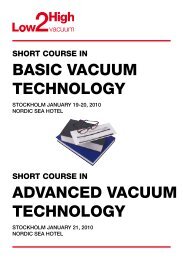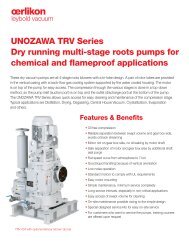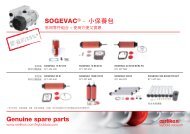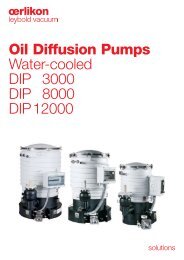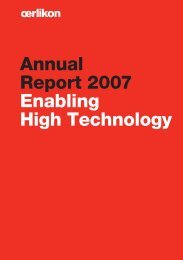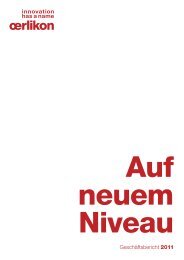Annual Report 2011 (5.07 MB, PDF-File) - Oerlikon
Annual Report 2011 (5.07 MB, PDF-File) - Oerlikon
Annual Report 2011 (5.07 MB, PDF-File) - Oerlikon
You also want an ePaper? Increase the reach of your titles
YUMPU automatically turns print PDFs into web optimized ePapers that Google loves.
Securing our future<br />
The company’s management views sustainability as a competitive<br />
advantage: the more sustainable the company, the more<br />
attractive it is to investors, customers, employees and prospective<br />
employees. For investors, sustainability is becoming<br />
an increasingly important consideration in making investment<br />
decisions. A growing number of institutional investors carefully<br />
review environmental data before committing investment<br />
capital.<br />
The company’s current level of sustainability data collection<br />
and reporting falls short of best practice. The continuation of<br />
the company having been in serious question just two years<br />
ago, management has focused its resources on restructuring<br />
the company and laying the foundation for sustainable growth.<br />
Now that profitability has been restored, <strong>Oerlikon</strong> is committed<br />
to improving and expanding sustainability reporting on all of its<br />
commercial activities, now and into the future.<br />
Improving the environmental footprint<br />
Many <strong>Oerlikon</strong> products are designed to directly or indirectly improve<br />
the environmental footprint of customers and end users.<br />
These products are frequently part of the production process for<br />
environmental technologies and energy conserving systems.<br />
<strong>Oerlikon</strong> thus produces two sets of benefits. First, customers<br />
benefit from business success afforded by higher quality products,<br />
increased productivity or lower energy costs. Second, society<br />
benefits from access to new technologies which better<br />
protect the environment and improve quality of life.<br />
In its Textile Segment, <strong>Oerlikon</strong>’s product development work is<br />
concentrated on lowering energy consumption and increasing<br />
machinery and systems efficiency. Other areas of focus are<br />
improved ergonomics, noise reduction and minimization of<br />
equipment footprints. Since 2005, machinery and systems<br />
that use at least 20 % less energy than the generally accepted<br />
market standard are awarded an “e-save” certification from<br />
the internal quality-control office. In <strong>2011</strong>, <strong>Oerlikon</strong> Textile introduced<br />
seven newly developed textile machines to the market<br />
which use considerably less energy and have significantly<br />
higher productivity.<br />
47<br />
<strong>Oerlikon</strong>’s Drive Systems Segment is active in two environmental<br />
technologies. First, wind power: <strong>Oerlikon</strong> supplies a major<br />
American wind-energy company with components (ring gears,<br />
gear drives, etc.) that are assembled into complete gear transmissions<br />
and sold worldwide. Second, electric vehicles:<br />
<strong>Oerlikon</strong> equips electric vehicles with drive systems based on<br />
its sports-car expertise. These products deliver high torque at<br />
low speeds, good performance parameters when climbing<br />
steep grades, high top speeds and – thanks to high efficiency<br />
levels – improved range. A car-sharing program called “Autolib”<br />
launched in Paris at the end of <strong>2011</strong>, uses electric vehicles<br />
equipped with <strong>Oerlikon</strong> Drive Systems transmissions. About<br />
3 000 to 5 000 of these vehicles will be available for rent<br />
throughout the city.<br />
Many environmental technologies need to be manufactured in<br />
a vacuum. Making this possible is the job of the Vacuum Segment,<br />
which manufactures a variety of innovation vacuum systems<br />
and equipment. Without vacuum technology, there would<br />
be no solar modules, LEDs or insulated glass. Insulated glass,<br />
which is used to reduce energy costs in buildings, is created by<br />
covering plates of glass with a layer of metal, including silver,<br />
under vacuum or high-vacuum conditions. This transparent<br />
layer of metal, usually just 1/100 000 milli meter thick, prevents<br />
heat transfer from the building’s interior and improves the insulation<br />
value of glass alone by a factor of five. In wind power, vacuum<br />
technology is used extensively in the manufacture of turbine<br />
rotor blades, which are produced using a vacuum-infusion<br />
process. This process uses vacuums to create such a strong<br />
bond between the layers of fiber, that rotor blades of more than<br />
50 meters in length can be produced.<br />
<strong>Oerlikon</strong> Coating, which specializes in coating high-performance<br />
parts and materials in its 87 centers around the world,<br />
is a key contributor to increased fuel economy in today’s cars<br />
and trucks. In diesel engines, for instance, the introduction of<br />
high-pressure injection has resulted in a 30 % reduction in fuel<br />
consumption. High-pressure injection was made possible by<br />
the development of a coating for those engine components operating<br />
under severe conditions, such as fuel-injection pumps.




